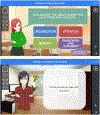User experience (re)design and evaluation of a self-guided, mobile health app for adolescents with mild Traumatic Brain Injury
- PMID: 33860150
- PMCID: PMC8046025
- DOI: 10.1007/s41686-019-00038-x
User experience (re)design and evaluation of a self-guided, mobile health app for adolescents with mild Traumatic Brain Injury
Abstract
Mild Traumatic Brain Injury (mTBI) is a significant cause of morbidity for adolescents. Currently, there is a lack of evidence-based interventions to address common sequelae of mTBI. To address this gap, we designed a program to promote recovery for adolescents following mTBI. Preliminary testing of the Self-Monitoring Activity Regulation and Relaxation Treatment (SMART) program demonstrated good usability but indicated a need for modifications to the program. The SMART application was redesigned with the addition of more interactive and gamified components. Content was also reframed to specifically target and engage adolescents with mTBI. We describe the usability evaluation of the updated SMART application. Children aged 11-18 years diagnosed with mTBI who were 1 to 6 months post mTBI were recruited to participate in a 1-2-hour usability session in which they thought aloud and responded to targeted usability-related questions during their interaction with the SMART program. After completing the session, participants rated their usability experience using the System Usability Scale (SUS) and rated the overall user-friendliness of the program. Participants' responses during the session were qualitatively coded and analyzed. Six adolescents participated in a usability session (average age = 13.7 years). On the SUS, participants rated the program as highly usable (M = 85.6, SD = 3.24). They also had overwhelmingly positive feedback regarding the content, design and structure of the program. Overall, findings suggest that the redesigned SMART program was usable, acceptable, and relevant to adolescents with mTBI. Based on adolescents' feedback, additional modifications were made before the program undergoes efficacy testing.
Keywords: adolescent; concussion; m-health; mTBI; recovery; rehabilitation.
Conflict of interest statement
Conflicts of Interest: The authors declare no conflict of interest. The funders had no role in the design of the study; in the collection, analyses, or interpretation of data; in the writing of the manuscript, or in the decision to publish the results.
Figures




Similar articles
-
Usability evaluation of the SMART application for youth with mTBI.Int J Med Inform. 2017 Jan;97:163-170. doi: 10.1016/j.ijmedinf.2016.10.007. Epub 2016 Oct 20. Int J Med Inform. 2017. PMID: 27919376 Free PMC article.
-
Adolescents with Mild Traumatic Brain Injury Get SMART: An Analysis of a Novel Web-Based Intervention.Telemed J E Health. 2017 Jul;23(7):600-607. doi: 10.1089/tmj.2016.0215. Epub 2017 Jan 23. Telemed J E Health. 2017. PMID: 28112591 Free PMC article.
-
Children's and Caregivers' Review of a Guided Imagery Therapy Mobile App Designed to Treat Children With Functional Abdominal Pain Disorders: Leveraging a Mixed Methods Approach With User-Centered Design.JMIR Form Res. 2023 Apr 19;7:e41321. doi: 10.2196/41321. JMIR Form Res. 2023. PMID: 37074773 Free PMC article.
-
A Mobile Phone-Based App for Use During Cognitive Behavioral Therapy for Adolescents With Anxiety (MindClimb): User-Centered Design and Usability Study.JMIR Mhealth Uhealth. 2020 Dec 8;8(12):e18439. doi: 10.2196/18439. JMIR Mhealth Uhealth. 2020. PMID: 33289671 Free PMC article.
-
A Mobile Phone App for the Self-Management of Pediatric Concussion: Development and Usability Testing.JMIR Hum Factors. 2019 May 31;6(2):e12135. doi: 10.2196/12135. JMIR Hum Factors. 2019. PMID: 31152527 Free PMC article.
Cited by
-
The MyGuide Web-Based Self-Management Tool for Concussion Rehabilitation: Mixed Methods Cross-Sectional Study.JMIR Rehabil Assist Technol. 2025 Jan 7;12:e59181. doi: 10.2196/59181. JMIR Rehabil Assist Technol. 2025. PMID: 39773679 Free PMC article.
-
Parental Knowledge, Self-confidence, and Usability Evaluation of a Web-Based Infographic for Pediatric Concussion: Multimethod Study.JMIR Pediatr Parent. 2022 May 10;5(2):e36317. doi: 10.2196/36317. JMIR Pediatr Parent. 2022. PMID: 35536631 Free PMC article.
-
Findings from a Randomized Controlled Trial of SMART: An EHealth Intervention for Mild Traumatic Brain Injury.J Pediatr Psychol. 2023 Mar 20;48(3):241-253. doi: 10.1093/jpepsy/jsac086. J Pediatr Psychol. 2023. PMID: 36565462 Free PMC article. Clinical Trial.
-
Gamification in Mobile Apps for Children With Disabilities: Scoping Review.JMIR Serious Games. 2024 Sep 6;12:e49029. doi: 10.2196/49029. JMIR Serious Games. 2024. PMID: 39240675 Free PMC article.
-
Exploring the use of a digital therapeutic intervention to support the pediatric cardiac care journey: Qualitative study on clinician perspectives.PLOS Digit Health. 2023 Dec 11;2(12):e0000371. doi: 10.1371/journal.pdig.0000371. eCollection 2023 Dec. PLOS Digit Health. 2023. PMID: 38079397 Free PMC article.
References
-
- Al Sayegh A, Sandford D, & Carson AJ (2010). Psychological Approaches to Treatment of Postconcussion Syndrome: A Systematic Review. Journal of Neurology, Neurosurgery & Psychiatry, 81(10), 1128–1134. - PubMed
-
- Anderson M, & Jiang J (n.d.). Teens, Social Media & Technology 2018. Retrieved September 27, 2019, from Pew Research Center website: https://www.pewinternet.org/2018/05/31/teens-social-media-technology-2018/
-
- Baker JG, Leddy JJ, Darling SR, Shucard J, Makdissi M, & Willer BS (2016). Gender Differences in Recovery From Sports-Related Concussion in Adolescents. Clinical Pediatrics, 55(8), 771–775. - PubMed
Grants and funding
LinkOut - more resources
Full Text Sources
Miscellaneous
